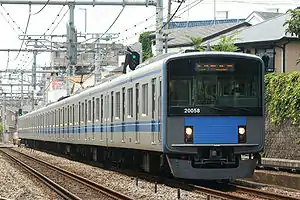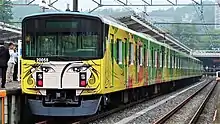Seibu 20000 series
The Seibu 20000 series (西武20000系) is an electric multiple unit (EMU) train type operated by the private railway operator Seibu Railway on commuter services in the Tokyo area of Japan since 2000.[1]
| Seibu 20000 series | |
|---|---|
 10-car set 20101 on the Seibu Ikebukuro Line in December 2018 | |
| Manufacturer | Hitachi |
| Built at | Kudamatsu, Yamaguchi |
| Family name | Hitachi A-train |
| Constructed | 1999–2005 |
| Entered service | 2000 |
| Number built | 144 vehicles (16 sets) |
| Number in service | 144 vehicles (16 sets) |
| Formation | 8/10 cars per trainset |
| Operator(s) | Seibu Railway |
| Depot(s) | Kotesashi, Minami-Iriso, Musashigaoka, Tamagawa-Josui |
| Line(s) served | |
| Specifications | |
| Car body construction | Aluminium |
| Car length | 20,000 mm (65 ft 7 in) |
| Doors | 4 pairs per side |
| Maximum speed | 105 km/h (65 mph) |
| Traction system | Variable frequency (IGBT) |
| Electric system(s) | 1,500 V DC |
| Current collection method | overhead catenary |
| Track gauge | 1,067 mm (3 ft 6 in) |
Fleet
As of 1 April 2017, the fleet consists of eight ten-car sets and eight eight-car (20050 series) sets, based at Kotesashi, Minami-Iriso, Musashigaoka, and Tamagawa-Josui depots for use on Seibu Shinjuku Line and Seibu Ikebukuro Line services.[2]
Formations
8-car sets
The eight-car sets (20151 to 20158) are formed as shown below with four motored (M) cars and four unpowered trailer (T) cars, and car 8 at the Shinjuku/Ikebukuro end.[2]
| Car No. | 1 | 2 | 3 | 4 | 5 | 6 | 7 | 8 |
|---|---|---|---|---|---|---|---|---|
| Designation | Tc1 | M1 | M2 | T1 | T3 | M5 | M6 | Tc2 |
| Numbering | 2015x | 2025x | 2035x | 2045x | 2075x | 2085x | 2095x | 2005x |
The M1 and M5 cars are each equipped with one single-arm pantograph.[2]
10-car sets
The eight ten-car sets (20101 to 20108) are formed as shown below with five motored (M) cars and five unpowered trailer (T) cars, and car 10 at the Shinjuku/Ikebukuro end.[2]
| Car No. | 1 | 2 | 3 | 4 | 5 | 6 | 7 | 8 | 9 | 10 |
|---|---|---|---|---|---|---|---|---|---|---|
| Designation | Tc1 | M1 | M2 | T1 | M3 | T2 | T3 | M5 | M6 | Tc2 |
| Numbering | 2010x | 2020x | 2030x | 2040x | 2050x | 2060x | 2070x | 2080x | 2090x | 2000x |
The M1, M3, and M5 cars are each equipped with one single-arm pantograph.[2]
Interior
Seating consists of sculpted longitudinal bench seating throughout, with an individual seat width of 460 mm (18 in) per person.[1] Wheelchair spaces are provided in the two outermost cars at each end.[2] Priority seats are provided at the end of each car.[2] Scrolling LED passenger information displays are provided above the doorways.[1]
 The interior of set 20101 in February 2014
The interior of set 20101 in February 2014 The interior of set 20106 in February 2014
The interior of set 20106 in February 2014 A wheelchair space in set 20101 in February 2014
A wheelchair space in set 20101 in February 2014 Priority seating at the end of a car in February 2014
Priority seating at the end of a car in February 2014
History
The first train was built in 1999, undergoing test running before entering revenue service in 2000.[1]
In August 2015, set 20101 was modified with full-colour LED destination indicators replacing the original three-colour LED type.[3]
Livery variations
Galaxy Express 999
From 8 October 2016, eight-car set 20158 operated in a special Galaxy Express 999 vinyl wrapping livery.[4] It is scheduled to operate in this livery until March 2019.[4]
 Set 20158 in Galaxy Express 999 livery (20058 end) in October 2016
Set 20158 in Galaxy Express 999 livery (20058 end) in October 2016 Set 20158 in Galaxy Express 999 livery (20158 end) in October 2016
Set 20158 in Galaxy Express 999 livery (20158 end) in October 2016
L-train
From 15 January 2018, two ten-car sets, 20104 and 20105, are scheduled to operate in a special "L-train" livery consisting of the Saitama Seibu Lions baseball team colour of dark blue with Seibu Lions logos.[5]
References
- 私鉄車両年鑑2013 [Japan Private Railways Annual 2013] (in Japanese). Tokyo, Japan: Ikaros Publications Ltd. 20 March 2013. p. 204. ISBN 978-4-86320-693-9.
- 私鉄車両編成表 2017 [Private Railway Rolling Stock Formations - 2017] (in Japanese). Japan: Kotsu Shimbunsha. 25 July 2017. p. 49–51. ISBN 978-4-330-81317-2.
- 西武20000系の行先表示がフルカラーLEDに [Seibu 20000 series destination indicator changed to full-colour LED type]. Japan Railfan Magazine Online (in Japanese). Japan: Koyusha Co., Ltd. 28 August 2015. Retrieved 28 August 2015.
- 西武鉄道で新「銀河鉄道999デザイン電車」の運転開始 [Seibu operates new "Galaxy Express 999 design train"]. Japan Railfan Magazine Online (in Japanese). Japan: Koyusha Co., Ltd. 9 October 2016. Archived from the original on 9 October 2016. Retrieved 9 October 2016.
- 西武鉄道 三代目"L-train"が運行を開始 [Third-generation Seibu "L-trains" to run]. Tetsudo Hobidas (in Japanese). Japan: Neko Publishing Co. Ltd. 12 January 2018. Archived from the original on 12 January 2018. Retrieved 12 January 2018.
External links
| Wikimedia Commons has media related to Seibu 20000 series. |
- Seibu 20000 series train information (in Japanese)
